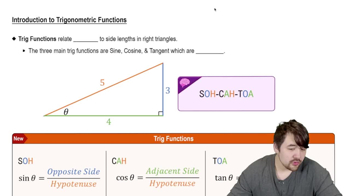Table of contents
- 0. Functions7h 52m
- Introduction to Functions16m
- Piecewise Functions10m
- Properties of Functions9m
- Common Functions1h 8m
- Transformations5m
- Combining Functions27m
- Exponent rules32m
- Exponential Functions28m
- Logarithmic Functions24m
- Properties of Logarithms34m
- Exponential & Logarithmic Equations35m
- Introduction to Trigonometric Functions38m
- Graphs of Trigonometric Functions44m
- Trigonometric Identities47m
- Inverse Trigonometric Functions48m
- 1. Limits and Continuity2h 2m
- 2. Intro to Derivatives1h 33m
- 3. Techniques of Differentiation3h 18m
- 4. Applications of Derivatives2h 38m
- 5. Graphical Applications of Derivatives6h 2m
- 6. Derivatives of Inverse, Exponential, & Logarithmic Functions2h 37m
- 7. Antiderivatives & Indefinite Integrals1h 26m
- 8. Definite Integrals4h 44m
- 9. Graphical Applications of Integrals2h 27m
- 10. Physics Applications of Integrals 2h 22m
3. Techniques of Differentiation
The Chain Rule
Problem 42
Textbook Question
Calculate the derivative of the following functions.
y = cos4 θ + sin4 θ
 Verified step by step guidance
Verified step by step guidance1
Step 1: Recognize that the function y = \cos^4 \theta + \sin^4 \theta is a sum of two terms, each raised to the fourth power. We will need to use the chain rule to differentiate each term separately.
Step 2: Apply the chain rule to the first term \cos^4 \theta. The chain rule states that if you have a function u(\theta) raised to a power n, the derivative is n * u(\theta)^{n-1} * u'(\theta). Here, u(\theta) = \cos \theta and n = 4.
Step 3: Differentiate \cos \theta with respect to \theta to find u'(\theta). The derivative of \cos \theta is -\sin \theta.
Step 4: Combine the results from Steps 2 and 3 to find the derivative of \cos^4 \theta. It will be 4 * \cos^3 \theta * (-\sin \theta).
Step 5: Repeat Steps 2-4 for the second term \sin^4 \theta. The derivative of \sin \theta is \cos \theta, so the derivative of \sin^4 \theta is 4 * \sin^3 \theta * \cos \theta. Finally, add the derivatives of both terms to get the derivative of the entire function.
 Verified video answer for a similar problem:
Verified video answer for a similar problem:This video solution was recommended by our tutors as helpful for the problem above
Video duration:
5mPlay a video:
Was this helpful?
Key Concepts
Here are the essential concepts you must grasp in order to answer the question correctly.
Derivative
The derivative of a function measures how the function's output value changes as its input value changes. It is a fundamental concept in calculus that represents the slope of the tangent line to the curve of the function at any given point. The derivative can be calculated using various rules, such as the power rule, product rule, and chain rule.
Recommended video:

Derivatives
Chain Rule
The chain rule is a formula for computing the derivative of the composition of two or more functions. It states that if you have a function that is the composition of two functions, the derivative can be found by multiplying the derivative of the outer function by the derivative of the inner function. This is particularly useful when dealing with functions raised to a power, as seen in the given problem.
Recommended video:

Intro to the Chain Rule
Trigonometric Functions
Trigonometric functions, such as sine and cosine, are fundamental functions in calculus that relate angles to ratios of sides in right triangles. They are periodic functions and have specific derivatives: the derivative of sin(θ) is cos(θ), and the derivative of cos(θ) is -sin(θ). Understanding these derivatives is essential for calculating the derivative of functions involving trigonometric expressions.
Recommended video:

Introduction to Trigonometric Functions

 5:02m
5:02mWatch next
Master Intro to the Chain Rule with a bite sized video explanation from Callie
Start learningRelated Videos
Related Practice






